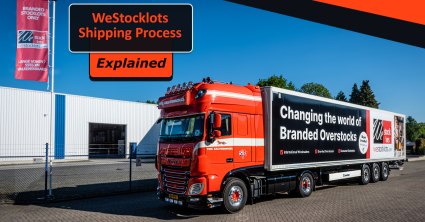
WeStocklots shipping process explained
If we would make an overview of subjects from ques...
Stocklots are undesired and a problem for most manufacturers, distributors, wholesalers and traders. On the other hand, it could be a real chance and overstocks could have a lot of pros too! We will explain how overstocks could be a chance instead of a problem in part I.
The term 'overstock' often has a sort of negative image around it because people tend to focus on the negatives of an overstock. We think that is not fair, overstocks could also be a big success because many companies get to deal with them. An estimated 80% of all the companies in the consumer products market has to deal with overstocks, now or in the future. What makes an overstock an overstock? There could be legions of reasons for the fact that a product turns into an overstock.
A product that deviates from a 'more neutral' product is a frequent reason for a product to turn into an overstock. Think of a wired headphone (wireless headphones are more popular now), a purple coffee machine (a more neutral colour like black or white is more demanded) or a lamp with a special design (lamps with standard shape fit in almost every interior). The demand for that kind of product normally is lower than the more neutral products.
When we look at our suppliers we often see that they mark products as overstocks when these products slow down their inventory turnover. Slowing down the inventory turnover results in less storage space and less liquidity for newer, more demanded products. An example of this is a product that's out of season, like a lawnmower. In spring and summer, there is a lot of demand for lawnmowers while in autumn and winter the demand drops. Therefore, the inventory turnover slows down in autumn and winter so companies will look for ways to clear them.
Another explanation why a product could turn into an overstock which we often hear is a simple one: overproduction. Mainly manufacturers work with forecasting when they produce products, they base their sales forecast on available data. Based on that 'prediction', manufacturers will produce the right amount of products. What if the forecast was too high? There will remain a quantity that can't be sold through regular distribution. Eventually, these products have a huge chance to turn into an overstock.
Overstocks, stocklots, excess inventory or surplus inventory (Restposten in German, restpartij in Dutch or surstock in French) are often End of Life products (EoL). This means that they're often in the decline phase of the product life cycle (PLC) and thus, according to theory, these products are less demanded by the consumer, contrary to products that are in the first phases of the PLC. The PLC shows us four different phases a product goes through in its 'lifetime'; from the first phase where the product is introduced on the market until the decline phase where the product is over its top. At WeStocklots we don't agree to the latter. Overstocks could be a great opportunity for every retailer or e-tailer but could also be a chance for manufacturers, distributors, traders and wholesalers. In parts II and III of this blog post, we will explain how overstocks could provide an opportunity.
You can find overstocks in many different shapes and forms, from brand new products to used products and from products with damaged packaging to untested returns. We can divide overstocks into three different categories: A goods, B goods and C goods. We will explain briefly what they mean and what to expect for every category.
A goods
A-goods are brand new products that are still in the original retail packaging. These products have never been opened and therefore have also never been used. If someone offers you A goods, you can assume that the goods are brand new. Warranty is not self-evident at a B2B deal, unlike when you buy a product as a consumer. At WeStocklots we buy and sell, almost only, A goods with a warranty of two years. If you as a customer face any defect whatsoever, we will always look for a solution with you. Click here to read how we work in these kinds of situations.
Our warehouse staff has a very tight process for checking incoming goods in our warehouse. We do this to ensure that the goods we buy and sell are brand new without any flaws so we can offer our customers only the best branded A goods.
B-goods
This category contains products that are, in short, have been used before but still work perfectly like they used to. What kind of products can you think of? Products with damaged packaging, products that are slightly damaged themselves or refurbished products. These products often have been used before and therefore aren't brand new but they still work as if they are brand new. The damage to the product or the packaging must not prevent the product to function properly, otherwise, the product will be grouped under the C goods.
C goods
Products in the C goods category are products that are partly or completely defective and therefore can't be sold to the consumer. Buyers of C goods buy these products to repair them or they use/sell parts of the product. C goods seldom have any warranty because they're sold as defective goods.
What about mixed pallets? Mixed pallets are very common in the stocklots market. Mixed pallets are often different kinds of B goods or C goods mixed on one (or multiple) pallets. As a buyer, you often have to pay per kilogram or pallet. As stated before in this blog post, we only buy and sell A goods at WeStocklots and therefore we only offer our products per piece. Curious to see what we buy and sell? Go check our current assortment here!